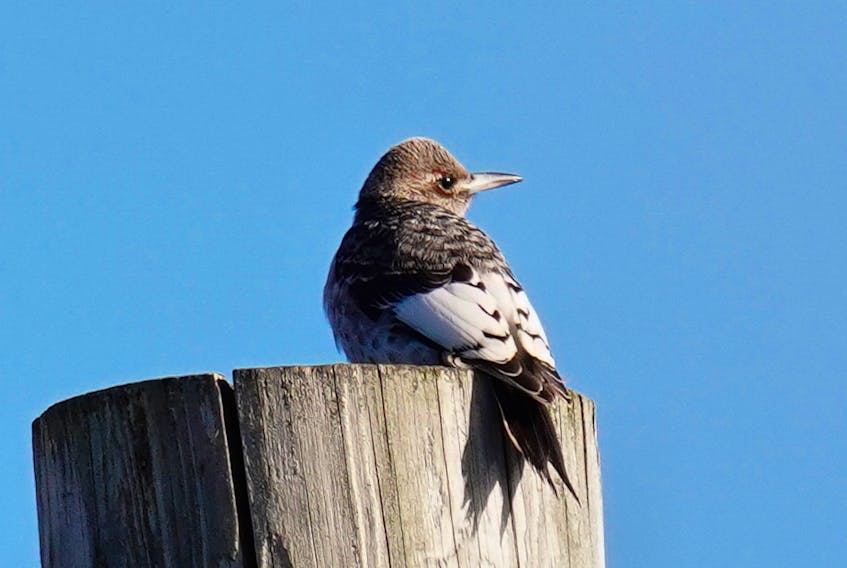People love their feeder birds. We keep a watchful eye on the birds that visit. There are the routine black-capped chickadees, juncos, flickers and American goldfinches to name a few. You may have a special visitor you favour. Maybe it is a red-breasted nuthatch, a mourning dove or a song sparrow. These are regular Newfoundland birds but are special for you when they are at your bird feeder. At my bird feeder in the Waterford Valley, St John’s our special individual bird is a male downy woodpecker. Having this little fellow with us daily makes it special to us. No two bird feeders get exactly the same selection of birds. Many things affect what your bird feeder attracts. The habitat in the area of your dwelling is perhaps the biggest influence on what kinds of birds you are likely to attract. But sometimes a bird shows up at a bird feeder that is nothing short of being an off the wall event. This happened to Gerri and Derek White of O’Regans in the southwest corner of the province. They posted pictures of the unfamiliar woodpecker on the Newfoundland Birding Facebook. The hard core birders in the province practically jumped out of their skin when they saw the picture. It was a red-headed woodpecker. The only previous record for the province of Newfoundland and Labrador was in October 1991 at a bird feeder in St. John’s.
The O’Regans bird was an immature with a brown head. It will earn its iridescent red head after surviving its first year of life. Red-headed woodpecker is a southern bird reaching the latitudes of Canada only in extreme southern Ontario. Even within its normal range in the eastern United States it occurs in localized pockets. It is especially fond of oak forests where it feeds on acorns in the fall and winter. It will eat seeds, peanuts and suet at a bird feeder. Most of the west coast birders flocked to O’Regans to get their view of the bird. It hung around for less than a week before departing. Hopefully it retraced its route back to where it belongs. However, it could survive a Newfoundland winter with a good supply of food at a bird feeder.
There have been other rare feeder birds this fall. A northern cardinal is everyone’s dream bird. They are a mainland species reaching Newfoundland on rare occasions. Well that rare occasion happened to Carolyn Lambe in Little St. Lawrence on the Burin Peninsula. Cardinals were made for bird feeders. That large triangular bill is perfect for cracking open their favourite food the sunflower seed. It may very well stay for the whole winter as cardinals have done so before on the Burin. There is no telling where a cardinal will show up next but late fall is the best time to dream about one showing up for you.
A white-winged dove joined the regular flock of mourning doves at Wendy Decker’s feeder in Portugal Cove-St. Philip's. The white-winged dove has an unexplainable record of long distance vagrancy. A few show up in the province every year even though their normal range comes closest to us in the state of Texas. This bird of hot arid places it has proven to us it can survive a Newfoundland winter with a steady supply of average bird seed. Less conspicuous and not quite so rare is a lark sparrow with the junco flock frequenting several birds feeder in Renews. Like the juncos it associates with, it scratches for seed on the ground beneath a bird feeder especially where the blue jays have been spilling seed. It will probably leave before the end of the month flying freely over COVID-19 restricted borders until it arrives in Mexico.
Baltimore orioles are regular fall visitors to Newfoundland with a number of them lingering late into the season. These bright orange birds with two conspicuous wing bars look pretty exotic when they visit bird feeders as the cooler weather sets in.
Usually they depart before true winter weather sets in. Grape jelly is their favourite food, but oranges cut in half are a close second. Various suet mixtures work as well.
Speaking of suet mixtures. You can buy readymade suet cakes sized to fit the popular suet cages found on the same shelf in your favourite hardware store. These work just fine. They are usually mixed with seed so they work for many birds. Juncos pick the seeds out the suet while the chickadees and woodpeckers go for the suet. You can get imaginative making your own suet mixtures. Always start with cooking lard made from animal fat and not the similar vegetable shortening. My latest concoction is 60 per cent lard and 40 per cent peanut butter mixed together with a liberal amount of corn meal.
This is what the downy woodpecker is loving.
Bruce Mactavish is an environmental consultant and avid birdwatcher. He can be reached at [email protected].









